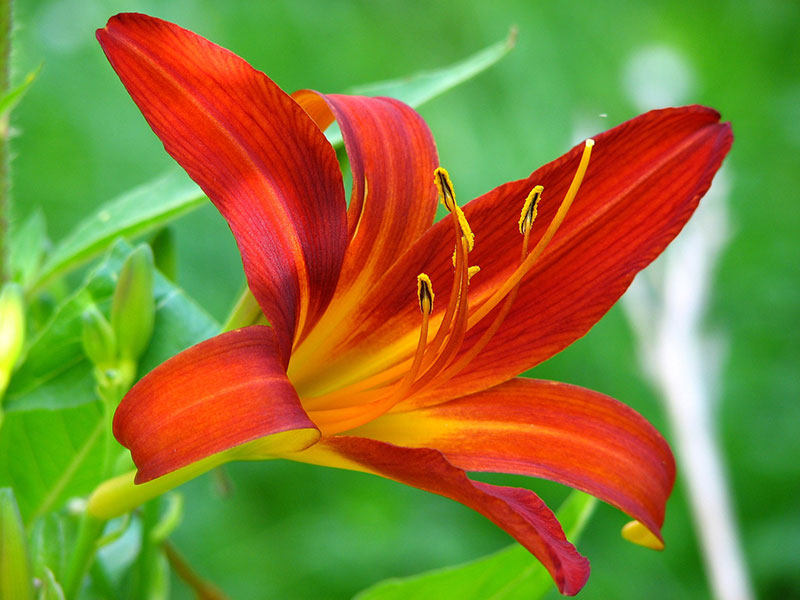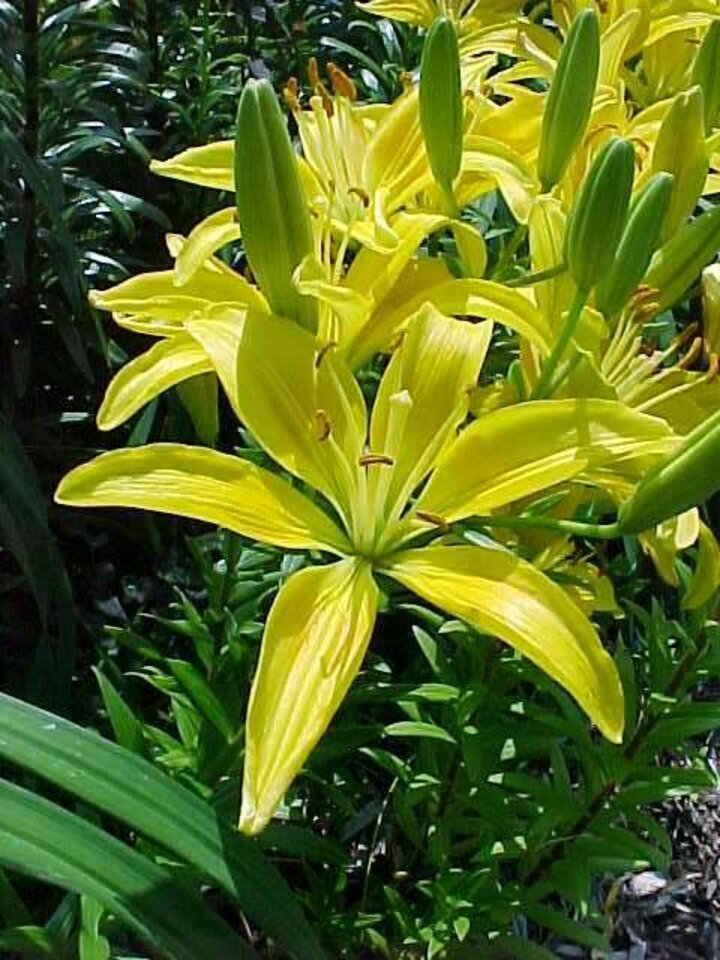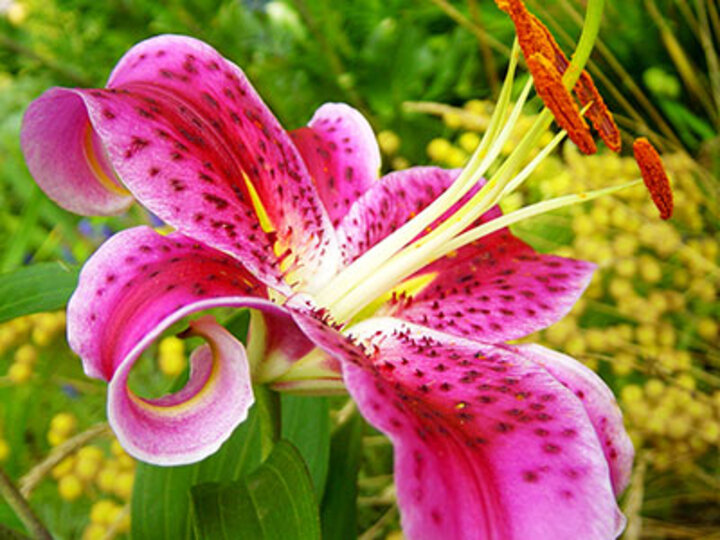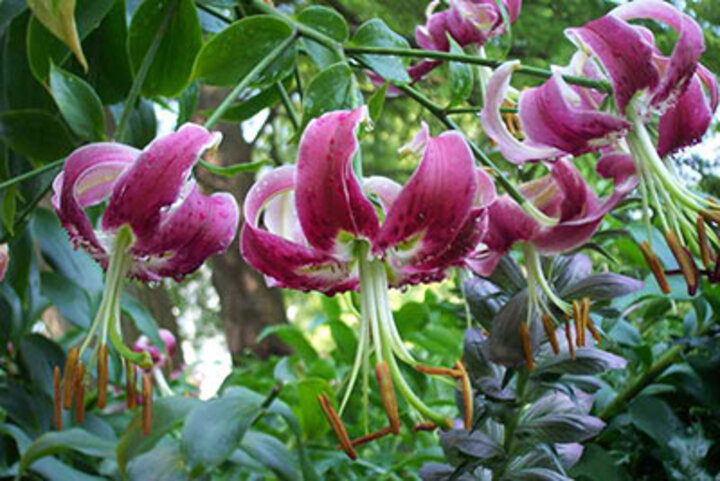Sarah Browning, Nebraska Extension Educator

Mid- summer is heralded by the beauty of lilies in the garden. Many plants have 'lily' as part of their common name, like daylily, surprise lily or calla lily, but these are not true lilies. Only plants in the genus Lilium are considered true lilies. Lilies grow from bulbs made of fleshy overlapping scales that don't have any protective outer husk or cover.
Plants have a stiff central stem and narrow linear leaves. Large, showy flowers are produced at the top of the stem, and may be either trumpet-shaped, bowl-shaped or bell-shaped with backwards reflexed petals. The flowers may nod downwards, face outward or look upward, and come is a wide variety of colors.

Planting & Care
Lilies are easy to grow, adding color and form to any garden. Bulbs can be planted in either spring or fall, from about mid-September through October. Fall planting is preferred, since it allows a longer period of time for root development before a flowering stalk is produced. If bulbs must be planted in spring, do it as early as possible.
Container-grown lily plants can be planted anytime during the summer, but lilies are more typically planted as bulbs. Each bulb should have plump, firm roots attached. Lily bulbs never go into full dormancy, as tulip bulbs do, so must be kept moist at all times until they are planted. If necessary, bulbs can be stored in the refrigerator for a short period of time, but preferably bulbs purchased at the garden center, or via mail order, are planted as soon as possible after they arrive.
Lilies required well-drained soil. Bulbs planted in wet soil quickly rot. Amend the planting area with organic matter, such as compost, if the native soil is heavy clay. Alternatively, if your soil is sandy, add compost to increase soil water holding capacity and provide additional nutrients.

Asiatic and Oriental lilies grow best in full sun; plants will get tall and lanky if placed in too much shade. However, Martagon hybrids can do well in partial shade.
Plant large bulbs 4-6 inches deep, and smaller bulbs 2-4 inches deep measured from the top of the bulb. For the best garden show, plant bulbs in groupings placing three or five identical bulbs approximately 8-12 inches apart. Space groupings three to five feet apart.
Each plant will produce several bulblets around its base. Divide and replant large bulb clusters about every three years, or when blooming is reduced.
Choosing Lilies
Choose from early, mid and late season cultivars to have color from June through September. Asiatic and Oriental lily are the most popular for Nebraska gardens. Lily hybridization has resulted in Orienpets (Oriental, trumpet lily cross) and Asiapets (Asiatic, trumpet lily cross).
Asiatic lilies are very easy to grow and not picky about soil type as long as it's well-drained. Plus they are very hardy and don't need staking in the garden. They have the widest range of colors, and upward or outward facing flowers that are often flecked with dark spots. Asiatic lilies are among the first to bloom and multiply quickly. They come in a wide range of heights, 2-5 feet. They're only drawback is a lack of fragrance.
- 'Connecticut King' is a deep golden yellow, height 3-4 feet, blooms in June
- 'Crete' is deep pink, height 3-4 feet, blooms in June/July

However, the large exotic, fragrant flowers of Oriental lilies are becoming increasingly popular. Plants are often taller than Asiatic lilies, 3-6 feet, and begin blooming in mid to late summer when the Asiatics are finishing. Oriental lilies perform best when protected from hot afternoon sun and strong winds in summer, and given extra mulch for winter protection.
- 'Black Beauty' Orientpet lily, dark red flowers edged with white, having a green central star, height 5-6 feet, blooms in July/August
- 'Star Gazer' is an Oriental lily with upward facing deep pink flowers flecked with crimson and with a white margin, height 2-3 feet, blooms in August
Turk's cap lily, or Lilium martagon is also a great choice. This lily has many smaller, downward facing flowers. The petals are strongly curved backward, giving it the common name Turk's cap. Flowers can be yellow-orange, yellow, white or burgundy and are often flecked or spotted. Plants range in height from 4-7 feet, blooming in early summer.
One final note, Easter lilies are not reliably hardy in Nebraska. However, a few gardeners can get them to overwinter, particularly if they are placed in a protected location and mulched heavily over winter. Easter lilies that do survive usually bloom in August.
Adding lilies to your garden this fall will provide beauty and color for years to come.
Images
- 'Connecticut King' lily, image from Missouri Botanical Garden.
- 'Stargazer' lily, image from Wikipedia.
- 'Black Beauty' lily, image from Missouri Botanical Garden.
Search Our Archive
Associated Video
Daylilies
Harmony Nursery in Benedict Nebraska grows over 450 varieties of daylilies.